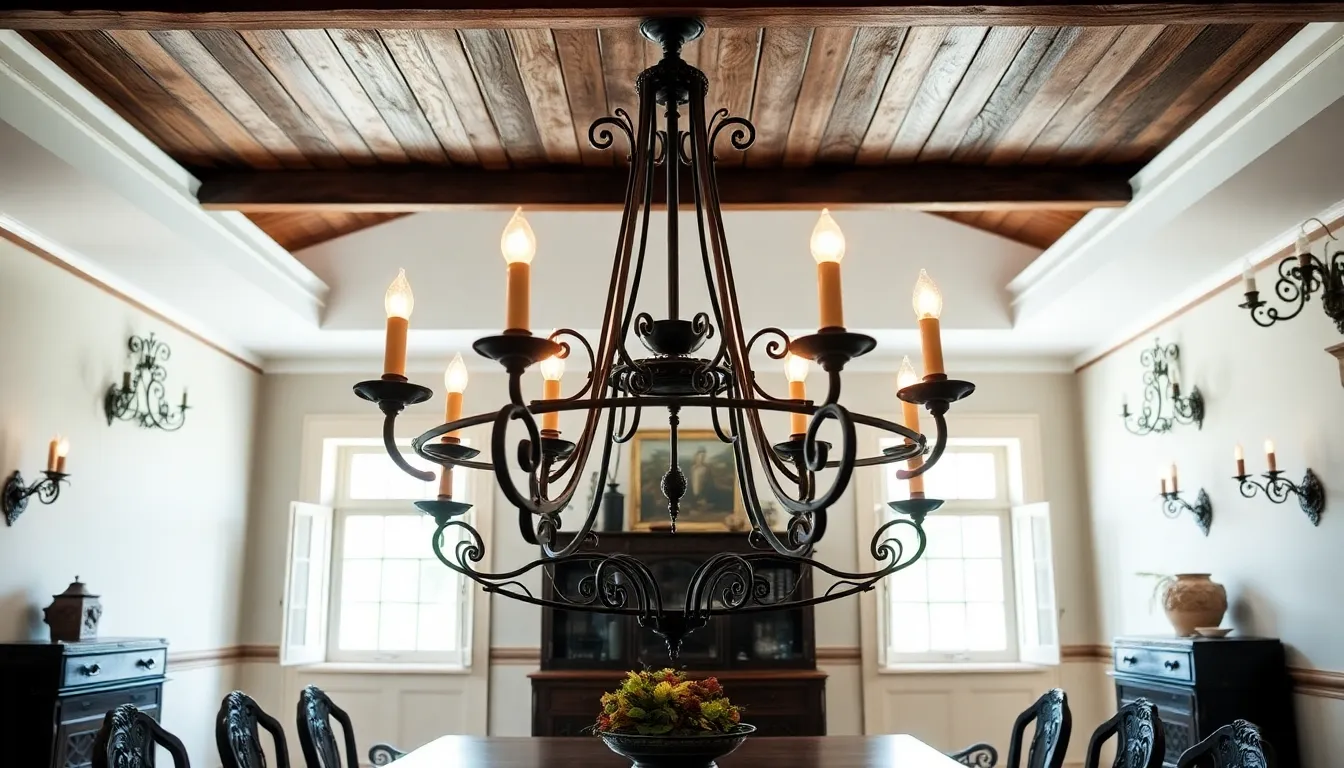Ah, colonial lighting. It’s more than just a flickering flame or a quaint antique, it’s a window into history that illuminates the past. Picture this: you walk into a room bathed in the warm glow of colonial-style light fixtures, where every flicker of candlelight seems to whisper tales from an era long past. Colonial lighting brings nostalgia, a sprinkle of charm, and a touch of elegance into modern homes. It’s not just about illuminating spaces: it’s about capturing the essence of a time when craftsmanship met functionality in the most beautiful ways. Let’s jump into this captivating world where history and style collide.
Table of Contents
ToggleColonial Lighting

Colonial lighting reflects a fascinating period influenced by varying European styles, especially English, Dutch, and Spanish designs, as settlers brought their tastes to the New World. During the colonial era, lighting sources were scarce. Initially, homes relied on sunlight and natural elements. But, as the evenings crept in, creative inventions emerged. Candles and oil lamps were the stars of the show. Those clever colonists quickly learned to capitalize on available resources, crafting lighting from tallow, beeswax, and whale oil.
In these early days, lighting technology was rudimentary. Still, the desire to illuminate space fostered innovation. For instance, the first chandeliers appeared in the late 1600s, often attached to ceilings and adorned with an array of candles. These stunning fixtures not only lit a room but served as status symbols. The rise of gas lighting in the late 18th century led to a shift, but colonial roots remained deeply embedded, influencing later designs and preferences.
Fast forward to today, and one can see the undeniable impact of these early designs in contemporary lighting. Understanding this historical context helps appreciate the art behind colonial lighting more deeply.
Types of Colonial Lighting
Colonial lighting encompasses a stunning variety of types, each with unique charm and functionality. Here are some key styles that defined the era:
- Candles: The primary source of light for many colonial homes, candles were crafted from tallow, beeswax, or bayberry wax. They were often placed in candlesticks or lanterns, creating a warm, flickering glow that turned each room into a cozy refuge.
- Lanterns: These portable light sources were essential for outdoor activities. They often used candles or oil as fuel and came in various designs, many featuring glass panels to shield the flames from the wind.
- Oil Lamps: By the 18th century, oil lamps started gaining popularity. The use of whale oil made these lamps not only efficient but also offered a consistent source of light, which was a game-changer for colonial homes.
- Chandeliers: Initially used in wealthier homes, chandeliers became a focal point in colonial interiors. They featured elaborate designs, often made of wrought iron or brass, and could accommodate multiple candles for a vibrant ambiance.
- Sconces: These wall-mounted fixtures combined beauty and utility, providing ambient light while conserving precious table space.
Materials Used in Colonial Lighting
In the quest for illumination, colonists utilized various materials, leveraging available resources to create functional and beautiful lighting.
- Wrought Iron: Known for its strength and durability, wrought iron was a go-to for crafting chandeliers and sconces, adding an industrial touch to colonial-style lighting.
- Brass: This shining metal was not only visually appealing but also resistant to corrosion. Brass became a popular material for candle holders and lamp bases, often polished to a high finish.
- Glass: As production techniques improved, glass became widely used for lanterns and lamps. The introduction of glass shades added elegance while allowing light to diffuse beautifully throughout a room.
- Wood: Wooden bases and candle holders were common, often intricately carved to add character to the home. Early colonists crafted these fixtures from local hardwoods, reflecting regional aesthetics.
These materials not only served practical purposes but also contributed to the distinct character of colonial lighting, marrying function with artistry.
Design Styles of Colonial Lighting
Colonial lighting design styles reveal the rich tapestry of influences from the various regions and cultures present during that time. Here are four predominant styles:
- Traditional New England: This style emphasizes simplicity and functionality. Fixtures were often crafted from wood and metal, featuring straight lines and minimal ornamentation. Think simple candle holders or unadorned oil lamps that let the light take center stage.
- Pennsylvania Dutch: This style boasted vibrant colors and intricate patterns, reflecting the cultural heritage of the German immigrants. Lanterns and candle holders often featured decorative motifs, making them more ornate than their New England counterparts.
- Southern Colonial: Rich materials and glamorous designs characterized the Southern approach to lighting. Larger chandeliers made from brass or wrought iron adorned dining rooms, creating a stately ambiance fit for entertaining guests.
- Spanish Colonial: With influences from Latin American designs, Spanish colonial lighting often featured wrought iron and the use of candles encased in glass or metal. This style introduced a rustic, artisanal quality that still resonates today.
The Role of Colonial Lighting in Interior Design
The role of colonial lighting extends beyond mere illumination: it significantly impacts the overall aesthetic and functionality of interior spaces. Here are some key ways colonial lighting plays a vital role:
- Creating Atmosphere: Colonial lighting evokes a sense of warmth and nostalgia, which can transform a room into an inviting sanctuary. Imagine gathering with family or friends under the soft, flickering glow of a candle-lit table: it creates moments to cherish.
- Focal Points: Chandeliers and lanterns often serve as statement pieces in a room. A beautifully crafted fixture catches the eye and draws attention, leading guests to appreciate the surrounding decor.
- Enhancing Other Design Elements: Colonial lighting complements various design styles. Whether it’s traditional rugs or contemporary furniture, these lighting pieces seamlessly enhance the overall look and feel of a space.
- Functional Layering: In residential design, layering different light types, from ambient to task lighting, is essential. Colonial lighting can serve multiple purposes, ensuring each space provides adequate illumination while maintaining a charming aesthetic.
Modern Interpretations of Colonial Lighting
Today, modern interpretations of colonial lighting are more popular than ever, blending traditional charm with contemporary sensibilities. Designers are eager to incorporate these elements into modern homes to create unique, inviting spaces:
- Reproductions: Many lighting companies specialize in reproducing colonial-style fixtures, making them accessible for all. These reproductions capture the essence of colonial designs while utilizing modern technology for energy efficiency.
- Hybrid Designs: A growing trend is merging colonial elements with contemporary styles. Think sleek, minimalist designs adorned with rustic candle-like bulbs that provide a nod to their historical roots while fitting seamlessly into modern aesthetics.
- Sustainable Materials: Modern interpretations often emphasize sustainability. Designers are looking at reclaimed wood or recycled metals to create colonial-inspired fixtures, reflecting today’s priority on eco-friendliness.



